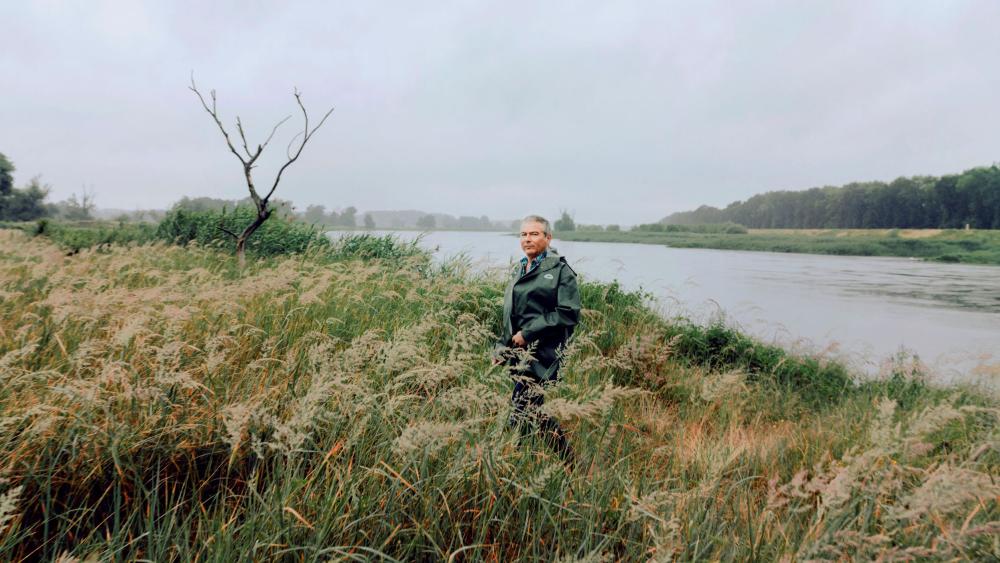
IGB fish ecologist Christian Wolter has almost three decades experience of researching the River Oder. | Photo: Lena Giovanazzi
It was not just a small fish [a German idiom for not a big deal] that had been found floating down the Oder river on 6 August 2022. Enormous quantities of fish of all species and sizes have perished. Over 200 tonnes of dead fish were pulled from a 160-kilometre stretch of the river – many more fish have sunk to the bottom or washed up on the banks.
The search for the cause of this catastrophic fish kill, which lasted for almost two weeks and affected the entire middle and lower reaches of the Oder, was like a detective story. Ultimately, a “culprit” was identified: an algal toxin from the prymnesin group.
Salinisation a cause of mass fish die-off in the Oder
Was it a natural disaster? Definitely not! Prymnesium parvum – the name of the toxin-producing algae strain – is a brackish water alga that grows in a salinity of two to 30 parts per thousand. For comparison: freshwater has less than one part per thousand salt content. A huge influx of salt was needed for a brackish water alga to find suitable living conditions in a river like the Oder and to develop on a massive scale.
These elevated salt levels in the Oder, far higher than the normal conductivity of water, were the direct cause of the disaster. It allowed algae of the species Prymnesium parvum to bloom, resulting in the production of significant amounts of the toxin.
Clearly, we must get to the bottom of the origin of the salt and the circumstances of its discharge so as to prevent such disasters in the future. But the real cause lies deeper.
Dammed rivers can lead to algal blooms
In a natural river, hundreds of different algae strains are present and reproduce. An algal cell divides approximately every 24 hours – but the river current means that it can never stay in one place long enough to form mass developments, referred to as algal blooms.
Damming the river has the effect of improving growth conditions for algae, because the flow velocity decreases and the residence time of the water increases. The latter is particularly high during low water levels in summer. And if then nutrients (of which there are plenty in the Oder), high temperatures and sunshine are added to the equation, algae multiply prolifically and “blossom”.
Low water levels, heat and salt – a toxic combination
The Oder was hit by combination of all these factors: damming, sunshine, high temperatures and the “pinch” of salt that led to the explosion of Prymnesium parvum, with more than 100,000,000 cells per litre and a correspondingly high toxin production.
Low water levels and high temperatures – impacts of climate change? Only partly. After all, the low water levels we are currently seeing are artificially enhanced because rivers have been deprived of their resilience to hydrological and climatic changes. Floodplains are natural buffer systems in the river landscape that lessen flood waves and store water for “dry days”.
River regulation plays a role in drainage during drought
Today, only 30 per cent of Germany’s historic floodplains are allowed to flood. Over the last 150 years, rivers have been straightened, resulting in a 23 per cent loss of their original length on average. Of the remaining stretches, 70 per cent have been dammed.
What is more, virtually all tributaries and 84 per cent of all islands have been removed. This has resulted in higher flow velocities, deeper rivers, and faster and deeper drainage of the river landscape. The floodplains store less water, which means that periods of low water levels in regulated rivers start sooner and last longer.
Climate change adaptation requires river restoration
Besides being an essential basis for mankind’s existence, intact riverine landscapes are centres of biodiversity. To promote their resilience and adaptation to climate change, natural processes for flood protection and water retention in the landscape must be revitalised, and interventions reduced or mitigated as far as possible.
Finally, damming to retain water does not constitute climate change adaptation. It promotes evaporation, retains sediments, and even contributes to depth erosion and landscape drainage downstream. The example of the Oder is a clear reminder of how a dammed river can become a new, non-natural habitat with “potential for catastrophy”.
The report was first published as a Terra X column on ZDF heute on 28 August 2022 >




